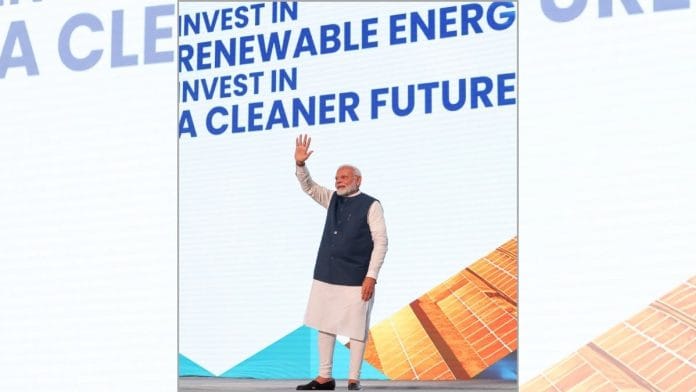New Delhi: The expansion of India’s solar capacity this year, its green hydrogen plans and offshore wind energy projects got a shoutout from Prime Minister Narendra Modi Monday Monday as he inaugurated the 4th Global Renewable Energy Investor’s Meet and Expo (RE-Invest) in Gujarat.
Modi highlighted the government’s BioE3 Policy and viability gap funding of over Rs 7,000 crore for offshore wind projects. He also mentioned a plan to generate 31,000 MW of hydro-power, for which the government has set aside Rs 12,000 crore.
The BioE3 policy was launched last month and aims to facilitate sustainable and efficient utilisation of biological resources.
The RE-Invest event, organised by the Ministry of New and Renewable Energy from 16 to 18 September in Gujarat, is held to showcase India’s renewable energy potential and invite more foreign investment.
The event also marked the end of the first 100 days of Modi’s third term in office, which he referred to as “a trailer” for the days to come. “The decisions we made in our first 100 days in office are a trailer of how we’re going to make India a developed country by 2047,” Modi said. The RE-Invest meet, he said, was part of a broader plan to achieve this “Viksit Bharat 2047” – the government’s vision to make India a developed country by the 100th year of Independence.
Within the first 100 days, the government has cleared 30 million more houses for the urban and rural poor, decided to build 12 new industrial cities, eight high-speed road corridor projects, 15+ Made in India semi-high-speed Vande Bharat trains, and set up a research fund of Rs 1 trillion, the prime minister said.
‘21st century’s best bet’
Kicking off the meet, Minister of New and Renewable Energy Pralhad Joshi said India planned to increase its non-fossil energy capacity to 500 GW by 2030 from the current 200 GW.
“Today, India is the fifth-largest and the world’s fastest-growing economy and we’re committed to meeting our energy needs sustainably,” Joshi said.
He elaborated on the growth in renewable energy generation from 193.5 BU to 360 BU between 2014 and now, an increase of almost 86 percent. The minister’s speech highlighted India’s achievements in co-founding the International Solar Alliance, meeting its Paris Agreement goals, and the expansion of rooftop solar through Pradhan Mantri Surya-Ghar Muft Bijli Yojana (PM-SGMBY).
“Banks and financial institutions have committed an additional $386 billion financing by 2030 for clean energy,” Joshi added.
Modi said the whole world considered India “21st century’s best bet” because of its unique diversity, scale, potential, and performance. He added that India was the first G20 country to achieve the Paris Agreement target of renewables forming 40 percent of its total energy capacity.
The prime minister said India had planned 17 “solar cities” which would be fully powered by renewable energy, adding that Ayodhya — the site of the newly-constructed Ram Janmabhoomi temple — would be one of them. Additionally, Indian Railways is expected to have net-zero emissions by 2030, while all of India’s petrol would have mandatory ethanol blending of 20 percent by 2025, the prime minister said.
Modi concluded on a lighter note, pointing out that his current renewable energy minister, Joshi, was previously the minister of coal. “Even my minister has transitioned from coal to renewable energy,” he laughed.
(Edited by Tikli Basu)






